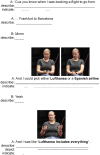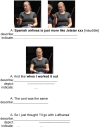Language as Description, Indication, and Depiction
- PMID: 29875712
- PMCID: PMC5974176
- DOI: 10.3389/fpsyg.2018.00716
Language as Description, Indication, and Depiction
Abstract
Signers and speakers coordinate a broad range of intentionally expressive actions within the spatiotemporal context of their face-to-face interactions (Parmentier, 1994; Clark, 1996; Johnston, 1996; Kendon, 2004). Varied semiotic repertoires combine in different ways, the details of which are rooted in the interactions occurring in a specific time and place (Goodwin, 2000; Kusters et al., 2017). However, intense focus in linguistics on conventionalized symbolic form/meaning pairings (especially those which are arbitrary) has obscured the importance of other semiotics in face-to-face communication. A consequence is that the communicative practices resulting from diverse ways of being (e.g., deaf, hearing) are not easily united into a global theoretical framework. Here we promote a theory of language that accounts for how diverse humans coordinate their semiotic repertoires in face-to-face communication, bringing together evidence from anthropology, semiotics, gesture studies and linguistics. Our aim is to facilitate direct comparison of different communicative ecologies. We build on Clark's (1996) theory of language use as 'actioned' via three methods of signaling: describing, indicating, and depicting. Each method is fundamentally different to the other, and they can be used alone or in combination with others during the joint creation of multimodal 'composite utterances' (Enfield, 2009). We argue that a theory of language must be able to account for all three methods of signaling as they manifest within and across composite utterances. From this perspective, language-and not only language use-can be viewed as intentionally communicative action involving the specific range of semiotic resources available in situated human interactions.
Keywords: depiction; indexicality; language; multimodal; semiotics; sign language.
Figures






Similar articles
-
Show Me What You've B/Seen: A Brief History of Depiction.Front Psychol. 2022 Jul 11;13:808814. doi: 10.3389/fpsyg.2022.808814. eCollection 2022. Front Psychol. 2022. PMID: 35936266 Free PMC article. Review.
-
Iconicity as Multimodal, Polysemiotic, and Plurifunctional.Front Psychol. 2022 Jun 13;13:808896. doi: 10.3389/fpsyg.2022.808896. eCollection 2022. Front Psychol. 2022. PMID: 35769755 Free PMC article.
-
Children's multimodal language development from an interactional, usage-based, and cognitive perspective.Wiley Interdiscip Rev Cogn Sci. 2023 Mar;14(2):e1631. doi: 10.1002/wcs.1631. Epub 2022 Nov 15. Wiley Interdiscip Rev Cogn Sci. 2023. PMID: 36377962 Review.
-
Neural systems supporting linguistic structure, linguistic experience, and symbolic communication in sign language and gesture.Proc Natl Acad Sci U S A. 2015 Sep 15;112(37):11684-9. doi: 10.1073/pnas.1510527112. Epub 2015 Aug 17. Proc Natl Acad Sci U S A. 2015. PMID: 26283352 Free PMC article.
-
Semiotic diversity in utterance production and the concept of 'language'.Philos Trans R Soc Lond B Biol Sci. 2014 Sep 19;369(1651):20130293. doi: 10.1098/rstb.2013.0293. Philos Trans R Soc Lond B Biol Sci. 2014. PMID: 25092661 Free PMC article. Review.
Cited by
-
Show Me What You've B/Seen: A Brief History of Depiction.Front Psychol. 2022 Jul 11;13:808814. doi: 10.3389/fpsyg.2022.808814. eCollection 2022. Front Psychol. 2022. PMID: 35936266 Free PMC article. Review.
-
A Usage-Based Proposal for Argument Structure of Directional Verbs in American Sign Language.Front Psychol. 2022 May 17;13:808493. doi: 10.3389/fpsyg.2022.808493. eCollection 2022. Front Psychol. 2022. PMID: 35664145 Free PMC article. Review.
-
Signed Languages: A Triangular Semiotic Dimension.Front Psychol. 2022 Jan 13;12:802911. doi: 10.3389/fpsyg.2021.802911. eCollection 2021. Front Psychol. 2022. PMID: 35095689 Free PMC article.
-
Looking at Viewpoint in ASL Through a Cognitive Linguistics Lens.Wiley Interdiscip Rev Cogn Sci. 2025 Mar-Apr;16(2):e70001. doi: 10.1002/wcs.70001. Wiley Interdiscip Rev Cogn Sci. 2025. PMID: 40107877 Free PMC article. Review.
-
A Study of Using Metaphoric and Beat Gestures with Motion-Based and Non-Motion-Based Metaphors during Retelling Stories.Behav Sci (Basel). 2022 Apr 29;12(5):129. doi: 10.3390/bs12050129. Behav Sci (Basel). 2022. PMID: 35621426 Free PMC article.
References
-
- Agha A. (2005). Voice, footing, enregisterment. 15 38–59. 10.1525/jlin.2005.15.1.38 - DOI
-
- Agha A. (2007). Cambridge: Cambridge University Press.
-
- Armstrong D. F., Stokoe W., Wilcox S. (1995). Cambridge: Cambridge University Press; 10.1017/CBO9780511620911 - DOI
-
- Bavelas J. B., Hutchinson S., Kenwood C., Matheson D. H. (1997). Using face-to-face dialogue as a standard for other communication systems. 22 5–24. 10.22230/cjc.1997v22n1a973 - DOI
-
- Bergman B., Dahl Ö. (1994). “Ideophones in sign language? The place of reduplication in the tense-aspect system of Swedish Sign Language,” in , eds Bache C., Basbøll H., Lindberg C.-E. (Berlin: Walter de Gruyter; ), 397–422.
LinkOut - more resources
Full Text Sources
Other Literature Sources

